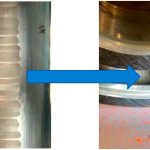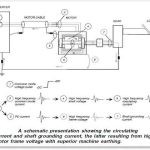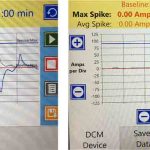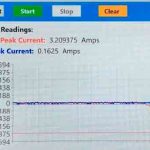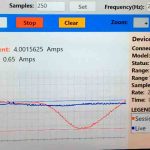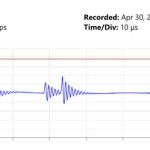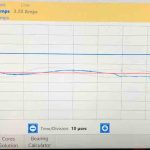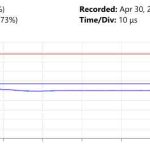Can a Motor Drive Harm an Elevator or Escalator System?
Aug 1, 2018
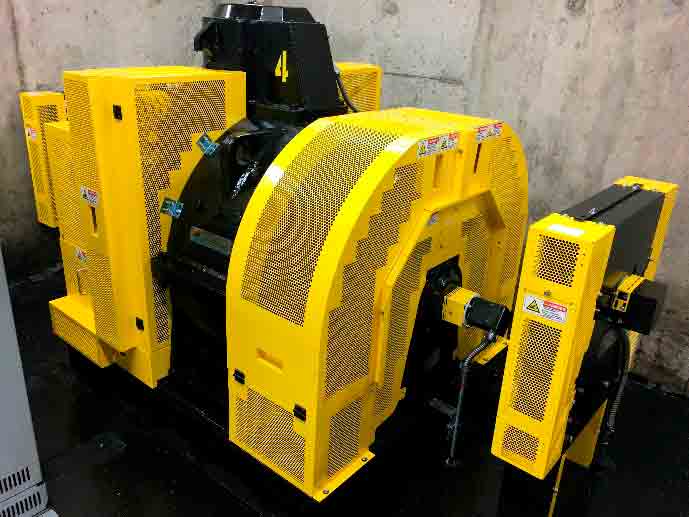
Testing to reduce high-frequency currents produced by VFDs and DC controllers is conducted.
Most modern elevator electric motors run via a variable-frequency drive (VFD) for AC motors and a DC controller (usually silicon-controlled-rectifier [SCR] based but, more recently for DC motors, insulated-gate-bipolar-transistor [IGBT] based) to control motor/elevator speed. Motor controllers save up to 55% in energy costs, but they can also create much electrical and audible noise. This electrical noise manifests as “voltage spikes” (which is really “common mode current” [CMC]) that can cause a great deal of fluting, frosting, lubrication breakdown and other damage to the bearings.
We at Renown Electric Motors & Repair wanted to seek out and test for a solution to this problem in elevator and escalator motors. We investigated the use of CoolBLUE inductive absorbers, a type of common mode choke we supply, to learn how they could reduce the high-frequency currents VFDs and DC controllers produce in an effort to reduce or eliminate motor bearing damage.
Background
VFD- and SCR-based control systems are not sinusoidal, but are a continuous generation of rectified signals or pulses (pulse-width modulation). The pulses have a constant voltage and a dV/dt rise and fall time of the pulse. Original VFD systems were based on bipolar junction transistors. The trend now, from Mitsubishi, On Semi, Infineon, ST Micro and other companies, is toward IGBT systems, which give a faster switching dV/dt, with lower switching losses and a more efficient drive.
IGBT systems create problems associated with system performance. The IGBT introduces parasitic currents in the form of two potentially destructive characteristics: transient voltage/ harmonic distortion/reflective waves and higher magnitudes of electrical ground noise current. AC Motor Drive systems utilizing variable-frequency controls produce high-frequency electrical noise. The noise is superimposed on the power drive lines of the motors in the form of common mode noise. The common mode noise creates a voltage (dV/dt) across the rotor/stator of the motor, resulting in a discharge current through the lubrication and motor bearings to the motor raceway.
This current discharge produces an electrical discharge machining effect that causes destructive pitting and damage to the motor raceway and premature lubrication breakdown. The result is premature failure of the motor, causing expensive repairs and system downtime.
DC Motors
To test our theory, we used a Rogowski coil, a toroidal coil specifically tuned to measure high-frequency current pulses superimposed on the control signal, on the output of an IGBT-based drive and an SCR-based drive. The drives were connected to a Bull and an Otis gearless DC Hoist motor, respectively. Both are in separate busy commercial retail and office complexes in downtown Toronto.
CMC was measured between the IGBT drive and Bull gearless DC motor. Normally, the units received spikes of roughly 10 A (Figure 5, left). However, while the building was under renovation, the units were subject to random spikes exceeding 115 A. Power interruptions, sags, surges and mainline voltage spikes can all lead to controller and drive damage, especially during generator testing. Unusually high building activity (such as in renovations) can also lead to destructive currents for the elevator system.
Figure 6 shows very low levels of CMC and, therefore, there is no need for changes to this SCR-drive system. The current is well within the current-carrying capacity of the bearing.
Results
With the elevator running, we used an oscilloscope and the Rogowski coil at the drive output and measured high-frequency current spikes going to the armature superimposed on the elevator motor control signal.
Tests conducted after installing CoolBLUE inductive absorbers and NaLA noise line absorbers showed CMC reduced at the drive output of roughly 55-85%. Testing on the ground also showed that, with these products installed, current was reduced to below 2 A, a 60% reduction. Both measurements are well within the safe range for the bearings’ current density ratings.
AC Motors
We installed a Rogowski Coil (used to measure A/C and high-frequency current pulses) on the output of the VFDs on an overhead AC gearless permanent-magnet (PM) machine and a 27-hp escalator motor to measure the actual electrical noise level caused by the switching of the IGBTs (Figures 8 and 9).
The Results
Typical results of the testing indicate a CMC being introduced by the IGBTs ranging from 21 to 30 A superimposed on top of the control signal. Note that there were already ferrite chokes on the systems; however, they did not measurably impact the noise level.
The CoolBLUE inductive absorbers were installed onto the output of the VFDs, and the system CMC (noise) was reduced by approximately 71-82%.
Additional Thoughts
The fields on a DC machine are subject to CMC, since they are controlled through the drive, as well. The standing voltage is generated from the IGBTs or SCR control. In the case of an SCR control, the fields will not be influenced in the same way it would with IGBTs. However, our experience shows that, in both cases, a charging effect happens in the fields and will need to be discharged somewhere. Generally, this is not a big issue, but, in some motors where the fields are near the interpoles, the charge jumps from the fields to the interpoles and creates a short. This can be avoided with better insulation in the motor, but, more practically, a shaft grounding brush can often discharge this low-frequency current to ground through the ropes.
At the time of this writing, we at Renown were just finishing a paper on the use of a shaft grounding brush with and without CoolBLUE and dV/dt filters. The highlight is that, in certain applications, low-frequency bearing current from the charging effect in the windings will build up, regardless of what is done to reduce CMC from the drive. Early results show that a shaft grounding brush can redirect the low-frequency current. Additionally, a dV/dt filter can help tremendously with medium frequencies and optimize control. Finally, CoolBLUE cores eliminate the high-frequency currents most often associated with bearing fluting.
Conclusion
After conducting tests of CoolBLUE inductive absorbers and NaLA noise line absorbers, Renown found that the absorbers perform very effectively to reduce CMC well within safe operating limits of the bearings. We recommend optimizing the number and type of absorbers, depending upon the particular motor with which they are to be installed. CMC reductions of around 65% can be expected. The absorbers will effectively eliminate the damage that leads to harmful vibrations, extending the life of your motor bearings and reducing maintenance needs.
- Figure 1: CMC can lead to bearing damage known as frosting and fluting.
- Figure 2: (l-r) Normal and target/ideal dV/dt
- Figure 3
- Figure 4
- Figure 5: Bull gearless DC hoist motor on IGBT drive
- Figure 6: Otis 219HT gearless DC hoist motor on SCR drive
- Figure 7: Significant reduction in CMC, in both frequency and amplitude, from an IGBT drive on a DC motor after the installation of inductive absorbers
- Figure 8: PM motors in this machine room were all subject to CMC spikes of 21-28 A. Typical issues were nuisance trips on the drive and a bearing failure on a deflector sheave.
- Figure 9: This view shows a typical spike and ringing seen between the drive and motor of an escalator. This is an image of the noise superimposed on the motor control signal because of the high-speed switching of the drive’s IGBTs.
- Figure 10: A PM gearless motor after installation of CoolBLUE inductive absorbers. Notice the amplitude of spikes has reduced, and the frequency is reduced significantly. Overall reduction in current is generally in the 60-85% range.
- Figure 11: An escalator unit’s similar response to inductive absorbers (CoolBLUE) with obvious reduction in the amplitude of current spikes and frequency.
Get more of Elevator World. Sign up for our free e-newsletter.
